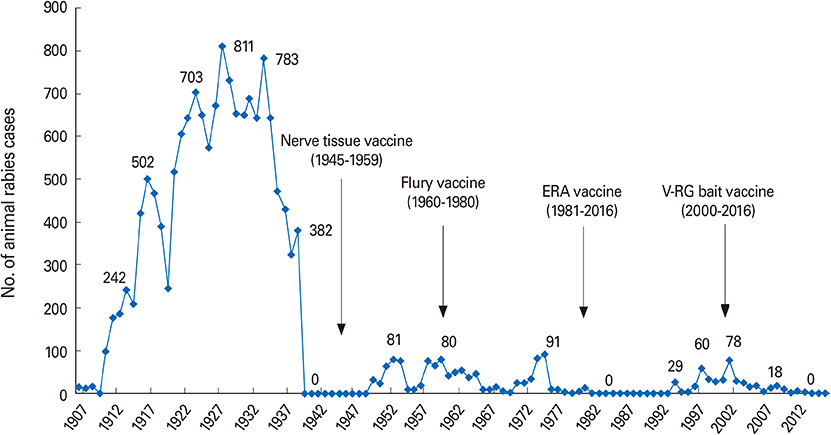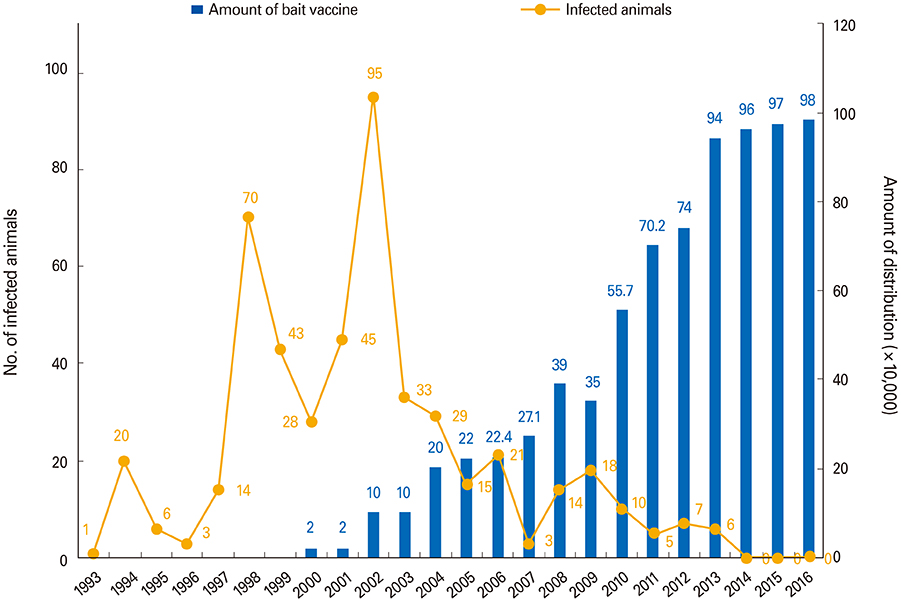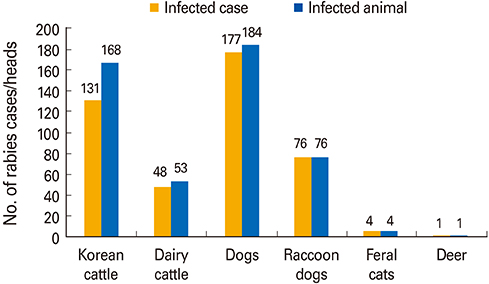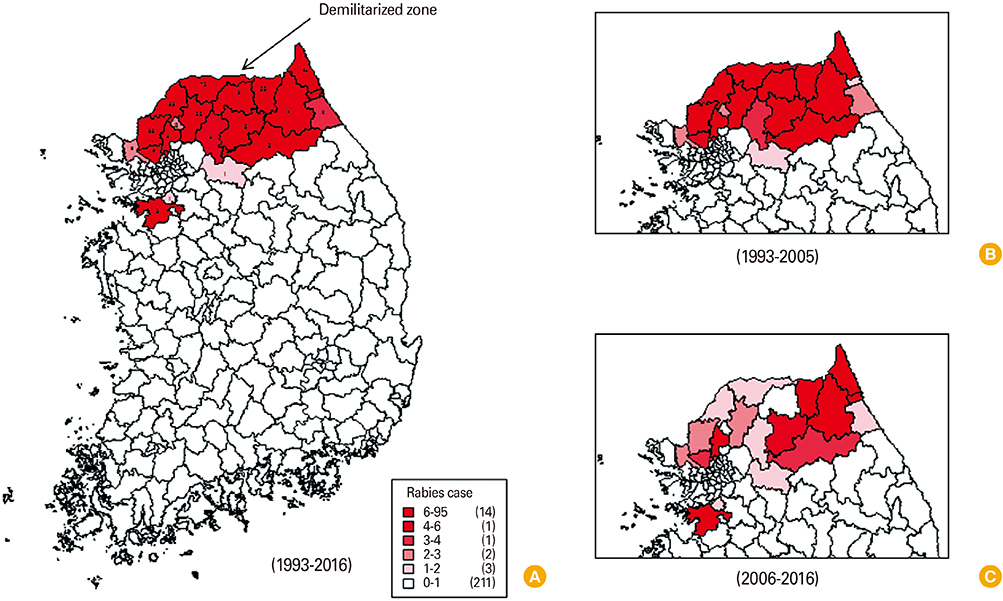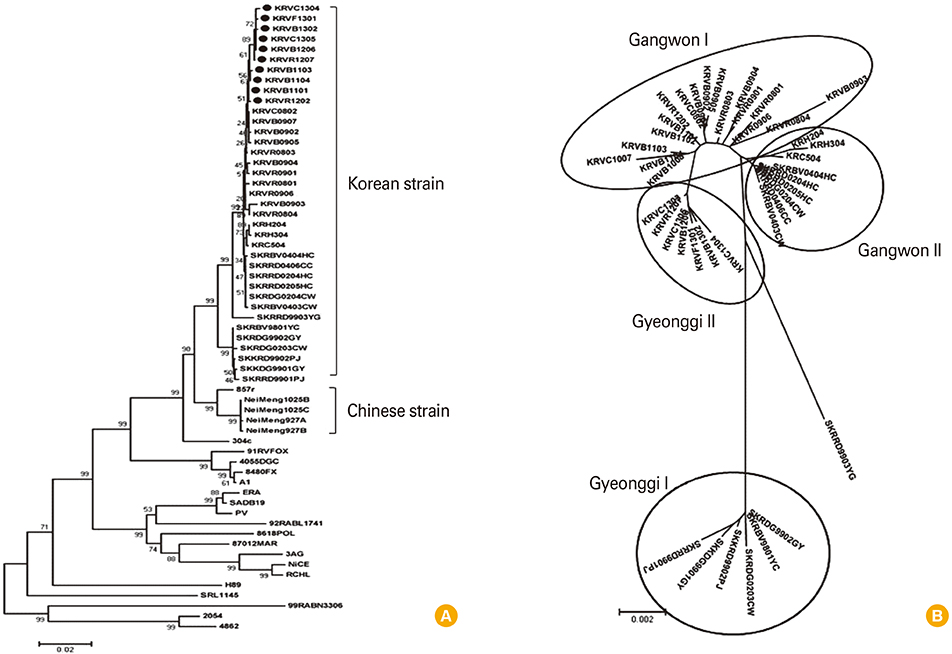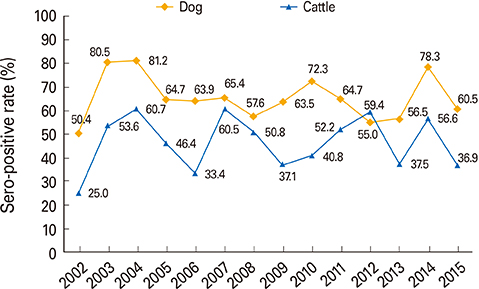Clin Exp Vaccine Res.
2017 Jul;6(2):111-119. 10.7774/cevr.2017.6.2.111.
Mass vaccination has led to the elimination of rabies since 2014 in South Korea
- Affiliations
-
- 1Viral Disease Division, Animal and Plant Quarantine Agency, MAFRA, Gimcheon, Korea. yangdk@korea.kr
- 2National Institute of Biological Resources, Ministry of Environment, Incheon, Korea.
- KMID: 2391571
- DOI: http://doi.org/10.7774/cevr.2017.6.2.111
Abstract
- PURPOSE
Rabies is one of the most fatal diseases, but it is 100% preventable in animals by vaccination. In this study, we present the epidemiological features of, and national preventive measures against, rabies in Korea.
MATERIALS AND METHODS
Data related to rabies and the population density of raccoon dogs in Korea were collected from the Animal and Plant Quarantine Agency, the Korean Centers for Disease Control and Prevention, and the National Institute of Environmental Research. Rabies diagnosis was confirmed with a fluorescent antibody test using brain samples of animals in accordance with the procedures described by the World Organization for Animal Health. Serological assays for dogs and cattle were conducted using the fluorescent antibody virus neutralization test.
RESULTS
From 1993 to 2016, a total of seven human rabies cases and 437 animal rabies cases in five different species were reported. An increase in the distribution of bait vaccine seemed to be related to a dramatic decrease in rabies prevalence in endemic rabies regions. Two Korean provinces and the capital city, Seoul, were involved in rabies outbreaks. Korean rabies strains are most closely related to the eastern Chinese strain belonging to the Arctic-like lineage. The yearly seropositive rates ranged from 50.4% to 81.2% in dogs and from 25% to 60.5% in cattle residing in endemic rabies regions.
CONCLUSION
This study indicates that national preventive measures, including mass vaccination and distribution of bait vaccines, have contributed to a substantial decrease in the number of rabies cases in Korea.
Keyword
MeSH Terms
-
Animals
Asian Continental Ancestry Group
Brain
Cattle
Centers for Disease Control and Prevention (U.S.)
Diagnosis
Disease Eradication
Disease Outbreaks
Dogs
Epidemiology
Humans
Korea*
Mass Vaccination*
Neutralization Tests
Plants
Population Density
Prevalence
Quarantine
Rabies*
Raccoon Dogs
Seoul
Vaccination
Vaccines
Vaccines
Figure
Cited by 2 articles
-
Strategies to maintain Korea's animal rabies non-occurrence status
Dong-Kun Yang, Ha-Hyun Kim, In-Soo Cho
Clin Exp Vaccine Res. 2018;7(2):87-92. doi: 10.7774/cevr.2018.7.2.87.Indirect ELISA for the Detection of Rabies Virus Antibodies in Dog Sera
Dong-Kun Yang, Ha-Hyun Kim, Seung Heon Lee, Miryun Ji, In-Soo Cho
J Bacteriol Virol. 2017;47(3):148-155. doi: 10.4167/jbv.2017.47.3.148.
Reference
-
1. Bourhy H, Kissi B, Tordo N. Molecular diversity of the Lyssavirus genus. Virology. 1993; 194:70–81.
Article2. Wunner WH, Larson JK, Dietzschold B, Smith CL. The molecular biology of rabies viruses. Rev Infect Dis. 1988; 10:Suppl 4. S771–S784.
Article3. Chang JC, Tsai KJ, Hsu WC, et al. Rabies virus infection in ferret badgers (Melogale moschata subaurantiaca) in Taiwan: a retrospective study. J Wildl Dis. 2015; 51:923–928.
Article4. Sultanov AA, Abdrakhmanov SK, Abdybekova AM, Karatayev BS, Torgerson PR. Rabies in Kazakhstan. PLoS Negl Trop Dis. 2016; 10:e0004889.
Article5. Hankins DG, Rosekrans JA. Overview, prevention, and treatment of rabies. Mayo Clin Proc. 2004; 79:671–676.
Article6. Kim CH, Lee CG, Yoon HC, et al. Rabies, an emerging disease in Korea. J Vet Med B Infect Dis Vet Public Health. 2006; 53:111–115.
Article7. Oem JK, Kim SH, Kim YH, Lee MH, Lee KK. Reemergence of rabies in the southern Han river region, Korea. J Wildl Dis. 2014; 50:681–688.
Article8. Recuenco S, Blanton JD, Rupprecht CE. A spatial model to forecast raccoon rabies emergence. Vector Borne Zoonotic Dis. 2012; 12:126–137.
Article9. Guo D, Zhou H, Zou Y, et al. Geographical analysis of the distribution and spread of human rabies in china from 2005 to 2011. PLoS One. 2013; 8:e72352.
Article10. Smith JS, Orciari LA, Yager PA, Seidel HD, Warner CK. Epidemiologic and historical relationships among 87 rabies virus isolates as determined by limited sequence analysis. J Infect Dis. 1992; 166:296–307.
Article11. Susetya H, Sugiyama M, Inagaki A, Ito N, Mudiarto G, Minamoto N. Molecular epidemiology of rabies in Indonesia. Virus Res. 2008; 135:144–149.
Article12. Masatani T, Ito N, Ito Y, et al. Importance of rabies virus nucleoprotein in viral evasion of interferon response in the brain. Microbiol Immunol. 2013; 57:511–517.
Article13. Cleaveland S, Barrat J, Barrat MJ, Selve M, Kaare M, Esterhuysen J. A rabies serosurvey of domestic dogs in rural Tanzania: results of a rapid fluorescent focus inhibition test (RFFIT) and a liquid-phase blocking ELISA used in parallel. Epidemiol Infect. 1999; 123:157–164.
Article14. World Organization for Animal Health. Manual of diagnostic tests and vaccines for terrestrial animals. 6th ed. Paris: World Organization for Animal Health;2012. p. 263–282.15. Cliquet F, Aubert M, Sagne L. Development of a fluorescent antibody virus neutralisation test (FAVN test) for the quantitation of rabies-neutralising antibody. J Immunol Methods. 1998; 212:79–87.
Article16. Joo YS, Lee JH, Lee KK, Bang HA, Lee WC. Retrospective study of extensive vaccination programs for canine rabies control and public health in Korea. Jpn J Infect Dis. 2011; 64:513–515.17. Yang DK, Kim HH, Lee KW, Song JY. The present and future of rabies vaccine in animals. Clin Exp Vaccine Res. 2013; 2:19–25.
Article18. Lee JH, Lee MJ, Lee JB, Kim JS, Bae CS, Lee WC. Review of canine rabies prevalence under two different vaccination programmes in Korea. Vet Rec. 2001; 148:511–512.
Article19. Lee KK. Outbreaks and control of animal rabies in Korea. Infect Chemother. 2010; 42:1–5.
Article20. Wilson ML, Bretsky PM, Cooper GH Jr, Egbertson SH, Van Kruiningen HJ, Cartter ML. Emergence of raccoon rabies in Connecticut, 1991-1994: spatial and temporal characteristics of animal infection and human contact. Am J Trop Med Hyg. 1997; 57:457–463.
Article21. Zienius D, Bagdonas J, Dranseika A. Epidemiological situation of rabies in Lithuania from 1990 to 2000. Vet Microbiol. 2003; 93:91–100.
Article22. Hyun BH, Lee KK, Kim IJ, et al. Molecular epidemiology of rabies virus isolates from South Korea. Virus Res. 2005; 114:113–125.
Article23. Park YJ, Shin MK, Kwon HM. Genetic characterization of rabies virus isolates in Korea. Virus Genes. 2005; 30:341–347.
Article24. Yang DK, Kim SY, Oh YI, et al. Epidemiological characteristics of rabies in South Korea from January 2004 to March 2011. J Bacteriol Virol. 2011; 41:165–171.
Article25. Johnson N, Black C, Smith J, et al. Rabies emergence among foxes in Turkey. J Wildl Dis. 2003; 39:262–270.
Article26. Wang C, Wang Y, Du X, et al. Rabies immunization status of dogs, Beijing, China. Emerg Infect Dis. 2011; 17:1129–1130.
Article27. Lalosevic D, Lalosevic V, Lazarevic-Ivanc L, Knezevic I. BHK-21 cell culture rabies vaccine: immunogenicity of a candidate vaccine for humans. Dev Biol (Basel). 2008; 131:421–429.
- Full Text Links
- Actions
-
Cited
- CITED
-
- Close
- Share
- Similar articles
-
- Strategies to maintain Korea's animal rabies non-occurrence status
- Rabies Outbreaks and Control during the Japanese Colonial Period in Korea
- Outbreaks and Control of Animal Rabies in Korea
- General Features and Post-Exposure Prophylaxis of Rabies
- Antibody Response in Cattle and Guinea Pigs Inoculated with Rabies Vaccines

